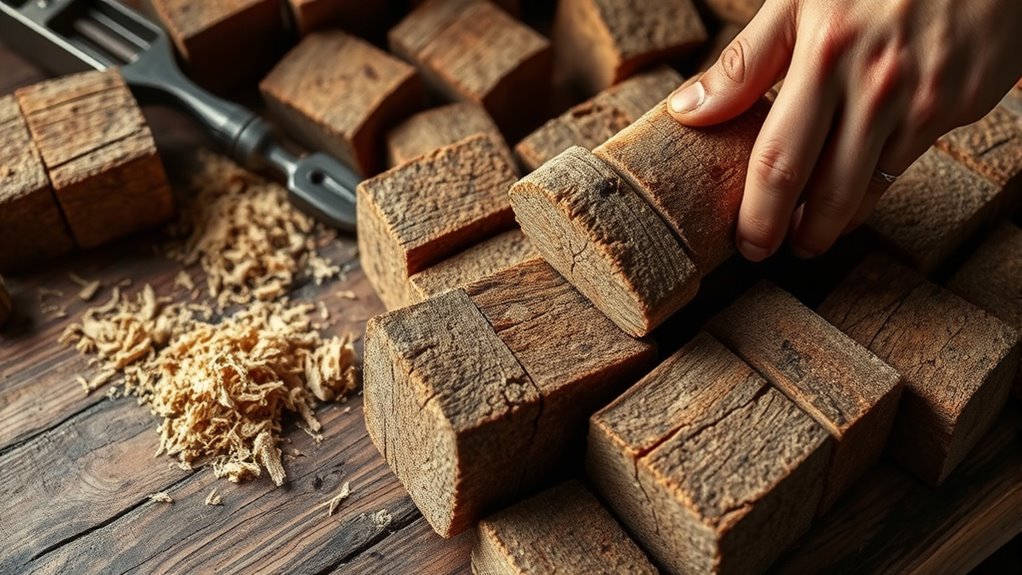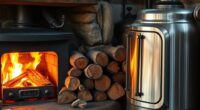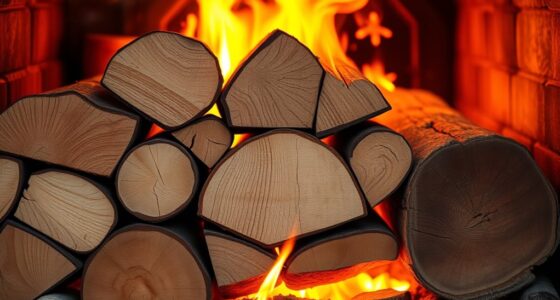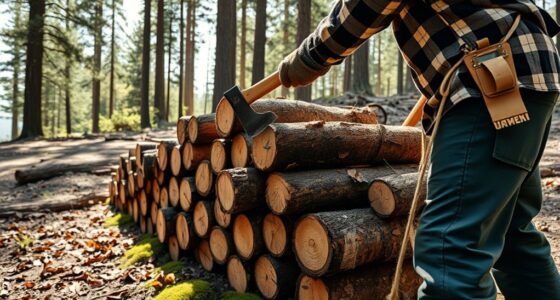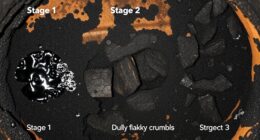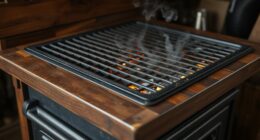To make wood briquettes at home, gather dry, clean wood scraps like sawdust or shavings. Use a manual or electric briquetting press to compress the material into dense blocks without binders. These briquettes burn efficiently, produce less smoke and ash, and are eco-friendly since they reuse waste. Properly formed briquettes are easy to store and transport, helping you reduce waste and enjoy cleaner, sustainable heating—keep exploring to see how to make and use them effectively.
Key Takeaways
- Collect dry, low-moisture biomass like sawdust or wood shavings for optimal briquette quality.
- Use a manual or electric briquetting press to compress biomass into dense, adhesive-free blocks.
- Store and dry briquettes properly to ensure efficient burning and reduce smoke emissions.
- Light and use briquettes in a suitable stove or fireplace for cleaner, longer-lasting heat.
- Making briquettes reduces waste, lowers environmental impact, and promotes sustainable, eco-friendly heating.
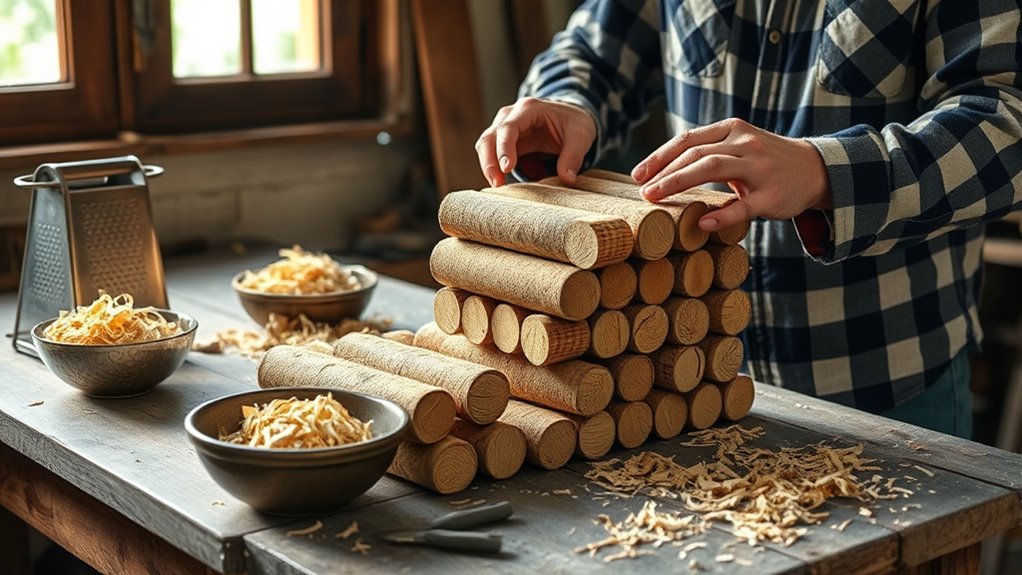
Making wood briquettes at home involves collecting and preparing your biomass material. You’ll need to gather sawdust, wood shavings, or small wood pieces, guaranteeing they’re dry to optimize combustion efficiency. Moisture content plays a vital role, as high moisture levels hinder proper burning and produce more smoke, which contributes negatively to the environment. Once your materials are dry, you can use a manual or electric briquetting press to compress the biomass into dense blocks. The pressing process binds the particles together without the need for adhesives or binders, which means your briquettes are free from chemical additives, further reducing their environmental impact. Using the correct equipment ensures a more uniform and high-quality briquette, enhancing burning efficiency and fuel longevity. Additionally, choosing low moisture content biomass materials helps improve the overall quality and performance of your briquettes.
The benefits of creating your own briquettes extend beyond cost savings. They produce less ash and smoke compared to traditional firewood or coal, leading to cleaner indoor air quality and less environmental pollution. Additionally, since you’re controlling the materials used, you can assure your fuel is sustainably sourced, making your heating method greener and more sustainable. The compact size and high energy density of briquettes make them easy to store and transport, so you can keep a supply on hand for cold months without clutter or waste. Moreover, creating your own briquettes can contribute to reducing waste by repurposing wood scraps that might otherwise be discarded. Understanding precious metals investment can also inspire sustainable practices in other areas of resource management.
Heating with homemade wood briquettes can be nearly carbon-neutral if you use locally sourced, recycled wood waste. This is because the carbon released during combustion is roughly equal to what the trees absorbed during their growth, creating a balanced carbon cycle. Unlike fossil fuels, which add new carbon to the atmosphere, briquettes made from renewable biomass help mitigate climate change. By choosing this alternative fuel, you’re supporting a more sustainable future, reducing your environmental impact, and encouraging responsible resource use. Exploring renewable biomass options can further enhance the eco-friendliness of your heating system.
Frequently Asked Questions
What Are the Best Types of Wood for Briquette Making?
You should choose hardwoods like oak, maple, or hickory for briquette making because they have high wood density, which helps produce dense, long-lasting briquettes. Avoid softwoods like pine or cedar, as they burn faster and produce more smoke. Dense woods provide better energy content and more consistent burning, making your briquettes more efficient and eco-friendly. Selecting the right types of wood ensures ideal performance for your homemade briquettes.
How Long Do Homemade Wood Briquettes Typically Last?
Homemade wood briquettes typically last about 1 to 2 years if stored properly, maintaining their quality for a decent storage duration. Their burn longevity depends on the wood type and compression but generally offers a steady, longer-lasting fire compared to loose wood. To maximize their lifespan and burn time, keep your briquettes in a dry, cool place away from moisture, which can diminish their effectiveness over time.
Can I Use Household Waste to Make Briquettes?
Yes, you can use household waste to make briquettes as an alternative fuel source. Just make sure you select non-toxic, dry materials like paper, cardboard, and certain agricultural scraps. Avoid plastics, treated woods, or hazardous waste, as these can release harmful fumes or damage your equipment. Properly processed household waste can be compressed into briquettes, providing a sustainable way to recycle and generate heat efficiently at home.
What Safety Precautions Should I Take During the Process?
You should always keep a fire extinguisher nearby and guarantee proper ventilation in your workspace to prevent fire hazards and inhaling dust or fumes. Wear gloves and a mask to protect your skin and respiratory system. Avoid overloading your workspace, and handle the briquetting equipment carefully. Regularly check your tools for safety, and work in a well-ventilated area to reduce the risk of accidents and health issues.
Are Homemade Briquettes Suitable for Outdoor or Indoor Use?
Homemade briquettes are suitable for outdoor grilling and outdoor heating but aren’t ideal for indoor heating due to potential carbon monoxide emissions. When used outdoors, they provide a clean, efficient fuel source. For indoor heating, opt for commercially made briquettes or other approved fuels to guarantee safety. Always prioritize proper ventilation and follow safety guidelines to prevent hazards when using briquettes indoors or outdoors.
Conclusion
By making and using wood briquettes at home, you not only save money but also reduce waste and emissions. Did you know that turning just one ton of wood waste into briquettes can save around 1.7 tons of CO₂ emissions? Imagine the positive impact you can have on the environment while staying warm and cozy. It’s a simple, eco-friendly choice that makes a big difference—start today and be part of the sustainable solution.

